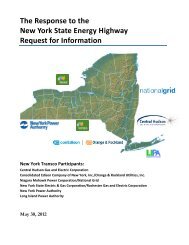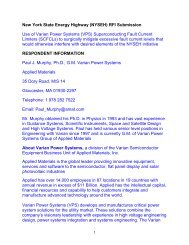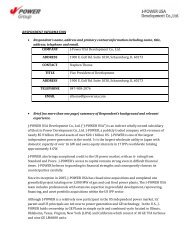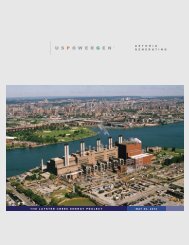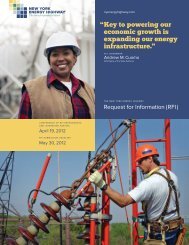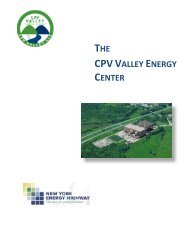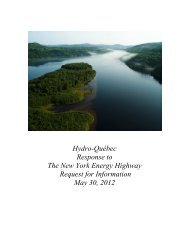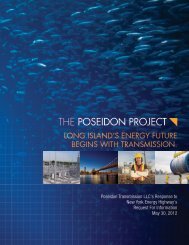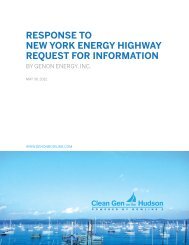Silicon Solution Joint Venture, LLC - Energy Highway
Silicon Solution Joint Venture, LLC - Energy Highway
Silicon Solution Joint Venture, LLC - Energy Highway
Create successful ePaper yourself
Turn your PDF publications into a flip-book with our unique Google optimized e-Paper software.
US SOLAR – WHITE PAPER 24 May 2012<br />
Table 3: Characteristics of potential investors<br />
Investor type Examples Preferred asset classes Investment horizon Targeted returns (a)<br />
<strong>Venture</strong><br />
capital<br />
• Accel Partners<br />
• Sequoia Capital<br />
• Early-stage companies<br />
and platforms<br />
• ~10 years (fund life)<br />
• ~3-5 years (exits for<br />
individual investments)<br />
• >30%<br />
'Development'<br />
private equity<br />
• KKR<br />
• Starwood <strong>Energy</strong><br />
• Infrastructure projects<br />
• Portfolios of projects<br />
• ~7-10 years (fund life) • ~10-20%<br />
Infrastructure<br />
debt funds<br />
• Hadrian's Wall<br />
• Macquarie Group<br />
• Direct infrastructure<br />
loans<br />
• Infrastructure debt<br />
securities<br />
• ~20 years<br />
• ~8-11% (low risk/operational<br />
projects)<br />
• ~11-15% (low/medium risk<br />
primary deals)<br />
Low returns / low risk – High returns / high risk<br />
Hedge funds<br />
Banks<br />
Large<br />
corporations<br />
Mutual funds /<br />
Retail<br />
investors<br />
Pension funds<br />
/ Endowments<br />
• Bridgewater<br />
• Soros Fund<br />
Mgmt<br />
• JP Morgan<br />
• US Bank<br />
• Apple<br />
• Chevron<br />
• Fidelity<br />
• T Rowe Price<br />
• National Pension<br />
Service of Korea<br />
• New York State<br />
Teachers<br />
• Yale Endowment<br />
• Liquid securities<br />
• Currently: project finance<br />
(construction and term<br />
debt), tax equity<br />
• Future: construction<br />
finance, tax equity<br />
• Cash<br />
• Short-term commercial<br />
paper and notes<br />
• Liquid, low-risk tax<br />
credits<br />
• Liquid securities<br />
• Various: willing to invest<br />
in managers (sometimes<br />
directly) across broad<br />
range of asset classes –<br />
eg, venture capital,<br />
equities, real estate<br />
• ~1 year<br />
• Debt:<br />
– Historically: >10 years<br />
– Currently: 5-10 year<br />
semi-perms<br />
• Tax equity: 5-10 years<br />
• 50% of fixed<br />
income on balance sheet<br />
• ~1-5 years for most other<br />
fixed income holdings<br />
• Corporate minority equity<br />
holdings<br />
• Quarterly, for some<br />
• ~1-2 years, for others<br />
• ~10+ for retirement<br />
portfolios<br />
• Annual (liability matching<br />
framework: ensure yearly<br />
liabilities are met)<br />
• 'Perpetuity' for overall fund<br />
lifetime<br />
• ~7-10% for absolute return funds<br />
• Maximise returns (~20%+) for<br />
aggressive funds<br />
• >7% (overall company earnings)<br />
• ~2.5-3% debt spreads over three<br />
month LIBOR (b)<br />
• ~7-8% tax equity after-tax yield<br />
for utility-scale PV, ~9% for<br />
distributed portfolios (unlevered),<br />
14-18% (levered)<br />
• >14% for tax equity structures<br />
favouring IRR over NPV<br />
• >7% (overall company earnings)<br />
• >LIBOR for fixed income holdings<br />
• >8% for tax equity (eg, lowincome<br />
housing)<br />
• ~6-8%<br />
• ~7-8%<br />
Utilities<br />
• Constellation<br />
• Tri-State G&T<br />
Coop<br />
• Power plants<br />
• Quarterly (overall company<br />
earnings)<br />
• >20 years (asset lifetimes)<br />
• ~11% required return on equity<br />
• ~5–6% WACC<br />
• ~4% dividend yield<br />
Insurance<br />
companies<br />
• AIG<br />
• Prudential<br />
• Fixed income to cover<br />
claims<br />
• Riskier assets to grow<br />
asset base<br />
• >20 years (long-term<br />
assets)<br />
• ~6% (long-term)<br />
• Maximise return<br />
Other stakeholders<br />
Vendors /<br />
EPC installers<br />
Landowners /<br />
Real estate<br />
developers<br />
Government<br />
• Bechtel<br />
• Trina Solar<br />
• Ted Turner<br />
• Vornado<br />
• California PUC<br />
• US Treasury<br />
• US Army<br />
• Pipelines / channels for<br />
their products<br />
• Land, buildings<br />
• ~3-5 years (companies<br />
looking to ensure future<br />
sales of their products)<br />
• ~10 years (fund lifetime)<br />
• >20 years (for individual<br />
holdings)<br />
• Projects • Long term • n.a.<br />
• ~2.5-3% debt spreads over threemonth<br />
LIBOR (b)<br />
• ~20-25% (development)<br />
• ~5% REIT dividend yield<br />
Source: Bloomberg New <strong>Energy</strong> Finance, interviews with each of these investor types. Note: The examples in the fourth column do not include any<br />
companies interviewed for this report; the examples are chosen because they are high-profile names within each investor type. Risk/return profiles<br />
are not representative of each financier in the above classes. Targeted return can vary considerably outside above range depending on investment<br />
type, risk, project stage, tenor, etc. (a) Targeted returns are net of fees, where applicable. (b) Total loan cost to developer is typically ~325 basis<br />
point (bps) spread over three-month LIBOR (~50bps) plus a 12-year swap (~230bps) to change loan from floating rate to fixed rate<br />
© Bloomberg New <strong>Energy</strong> Finance 2012<br />
Strictly no copying, forwarding, shared passwords or redistribution allowed without prior written permission<br />
of Bloomberg New <strong>Energy</strong> Finance. For more information on terms of use, please contact<br />
sales.bnef@bloomberg.net. Copyright and Disclaimer notice on page 28 applies throughout. Page 12 of 28



